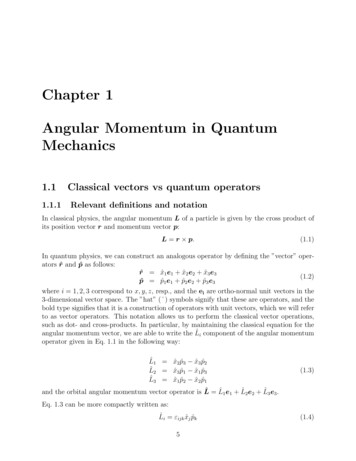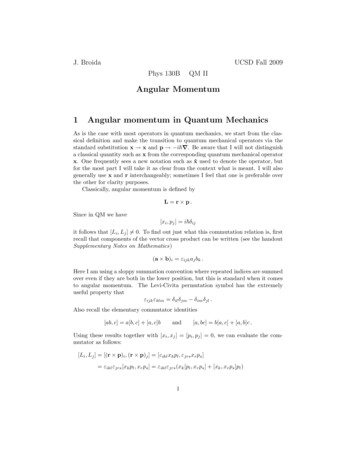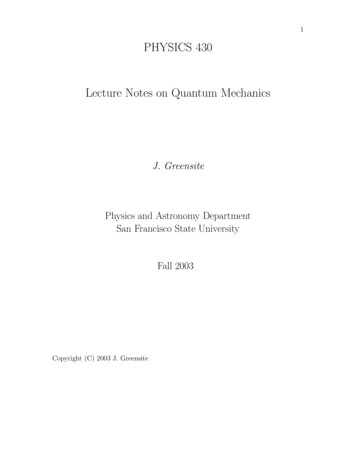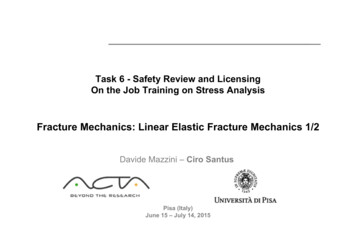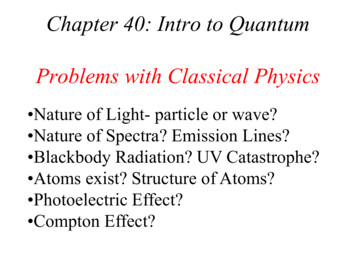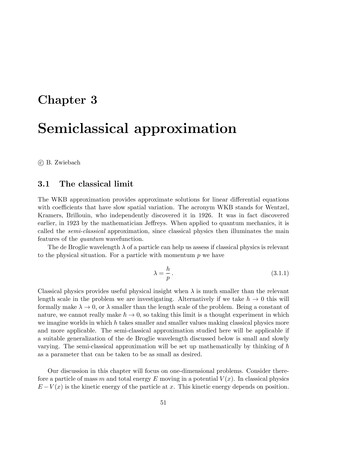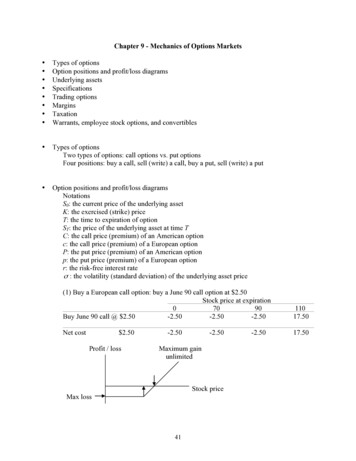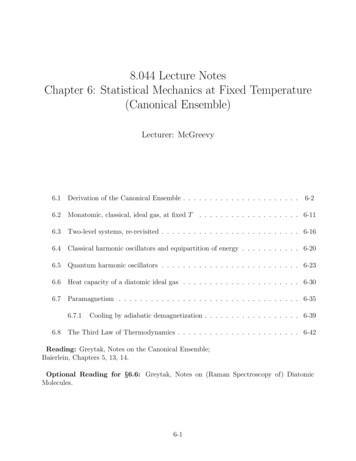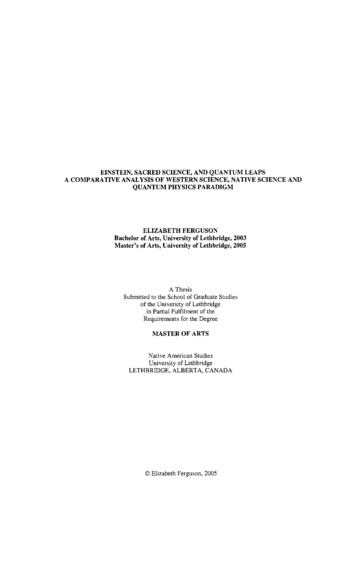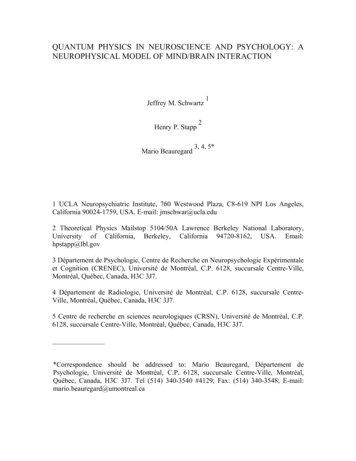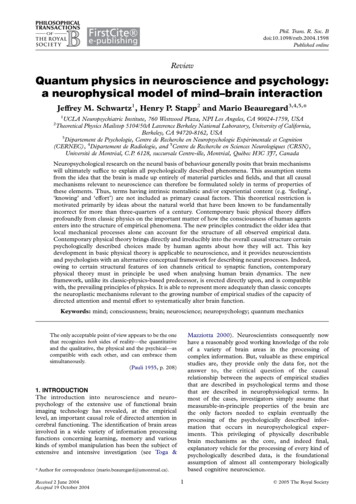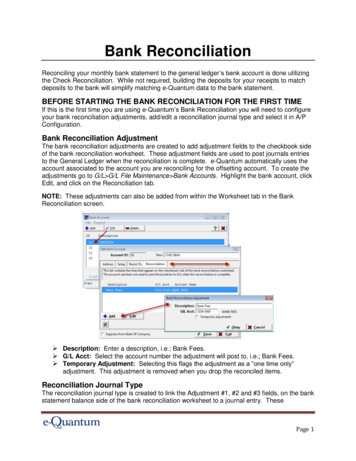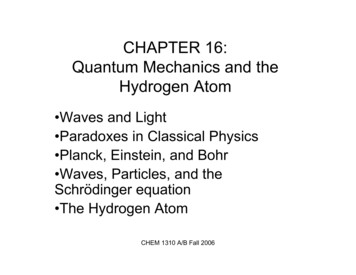
Transcription
CHAPTER 16:Quantum Mechanics and theHydrogen Atom Waves and Light Paradoxes in Classical Physics Planck, Einstein, and Bohr Waves, Particles, and theSchrödinger equation The Hydrogen AtomCHEM 1310 A/B Fall 2006
Questions What is quantum mechanics?When do we need it?What does it do?How does it apply to the H atom?CHEM 1310 A/B Fall 2006
Quantum Mechanics (QM)Quantum mechanics is The set of rules obeyed by small systems(molecules, atoms, and subatomicparticles) One of the two greatest achievements of20th century physics The basis for new research into smallerelectronic devices (e.g., quantum dots) Required to understand chemistryCHEM 1310 A/B Fall 2006
The two-slit experiment Fire very small particles at a barrier with twotiny slits in it expect a result like this:R. Shankar, Principles of Quantum MechanicsCHEM 1310 A/B Fall 2006
The two-slit experiment For very small particles, actually getsomething more like this R. Shankar, Principles of Quantum MechanicsAn interference pattern! Wavelike properties!CHEM 1310 A/B Fall 2006
Actual experiment with electronsResults of a double-slit experimentsending one electron through at atime. Numbers of electrons are(a) 10, (b) 200, (c) 6000, (d) 40000(e) 140000Strange: the wave-like interferencepattern happens even when wesend through only one electronat a time!!!CHEM 1310 A/B Fall 2006
Even stranger If we watch to see which slit a particle goesthrough, the interference pattern disappears andwe see the “expected” pattern! The experimentchanges depending on how we observe it! Richard Feynman (Nobel Prize in Physics,1965): “I think it is safe to say that no oneunderstands quantum mechanics. Do not keepsaying to yourself, if you can possibly avoid it,'but how can it be like that?' Nobody knowshow it can be like that." (The Character ofPhysical Law, 1965, p.129).CHEM 1310 A/B Fall 2006
QM: Historical Background Near the end of the 19th century, physiciststhought they knew everything Several key experiments showedsomething really unknown was going on QM developed to explain these unusualexperiments in early 1900’s ( 19001930’s) Developed around same time as theory ofrelativityCHEM 1310 A/B Fall 2006
Electromagnetic spectrumCHEM 1310 A/B Fall 2006
“Ultraviolet catastrophe”CHEM 1310 A/B Fall 2006
Planck to the rescue In 1900, Planck postulated thatthe blackbody is made of tinyoscillators with energiesproportional to the frequency ofoscillation, E n h ν, where his a constant (Planck’sconstant, 6.626E-34 J s) The equation means not justany energies are allowed. Onlycertain values are allowed.Energy is quantized. Using this hypothesis,blackbody radiation curves canbe predicted accuratelyCHEM 1310 A/B Fall 2006Max PlanckNobel Prize in Physics,1918
The Photoelectric Effect Light can cause electrons tobe ejected from a metalsurface Would expect electrons tobe ejected with greater KE ifgreater light intensity Problem: KE of electronsdoes not depend onintensity, but does dependon frequency νCHEM 1310 A/B Fall 2006
Einstein to the rescue Borrowed Planck’s“quantum” idea --- maybelight might havequantized energy levels,too! Light comes in “packets”of energy E hν, called“photons” Explains the photoelectriceffect --- higher ν, moreenergy in each lightpacket (photon), kicks outelectron with more KEAlbert EinsteinNobel Prize in Physics, 1905,for explaining thePhotoelectric EffectCHEM 1310 A/B Fall 2006
Photoelectric effect explainedMinimum energy to remove an electron is hν0, the“work function” of the metalCHEM 1310 A/B Fall 2006
Atomic/molecular SpectraIndividual lines. Why?CHEM 1310 A/B Fall 2006
H atom spectrum The lines follow a particular pattern Lines fit the “Rydberg formula”ν (1/n2 – 1/m2)(3.29 x 1015 s-1)where n and m are integers. Amazing!CHEM 1310 A/B Fall 2006
Bohr to the rescue Bohr (1913) borrowed ideas ofquantization from Planck andEinstein and explained the Hatom spectrum Bohr argued that angularmomentum was quantized --leads to quantization of H atomenergy levels Bohr frequency condition: E hν Equations match the Rydbergformula to an accuracy notseen previously in all ofscienceNiels BohrNobel Prize in Physics, 1922,for explaining H atomspectrumCHEM 1310 A/B Fall 2006
Bohr’s solution Quantization of angularmomentum Leads to quantization of radii(“Bohr orbits”) Leads to quantization of energies Assume the “Bohr frequencycondition” Yields the same “Rydbergformula” for allowed energylevels!!!a0 1 bohr (0.529 Å), Ry 1 Rydberg 2.17987 x 10-18 JCHEM 1310 A/B Fall 2006
H atom spectrum explainedMcQuarrie, “Quantum Chemistry”CHEM 1310 A/B Fall 2006
“New quantum theory” The “quantization” idea was groundbreaking, butit did not have a firm foundation De Broglie (1924) realized that if light can act asa wave and a particle, then maybe particles likeelectrons can also act like waves! (Recall 2-slitexperiment ) “Wave/particle duality” also worksfor matter! Can relate momentum (particle property) towavelength (wave property) via the de Broglierelationλ h/p(p mv)CHEM 1310 A/B Fall 2006
Proof of de Broglie relationfor a photon (Einstein)CHEM 1310 A/B Fall 2006
The Schrödinger Equation 1925: Schrödingerdeveloped newmechanics for “matterwaves” shown by deBroglie. Quantummechanics!Austrian 1000 Schilling bank noteErwin SchrödingerNobel Prize in Physics, 1933,for the Schrödingerequation, the foundation ofquantum mechanicsCHEM 1310 A/B Fall 2006
The Schrödinger Equation Nuclear kinetic energy Electron kintetic energy Nuclear/electron attraction Nuclear/nuclear repulstion Electron/electron repulsionCHEM 1310 A/B Fall 2006
The Schrödinger Equation Ψ is the wave function. It gives theamplitude of the matter wave at anyposition in space (for more than 1 electron,need the coordinates xi {xi, yi, zi} foreach particle i) Ψ(x1, x2, , xn) for n particles Focus on wave function for a singleparticle (like an electron) for now CHEM 1310 A/B Fall 2006
Classical standing waves String tied to the wall at bothends (x 0 and x L) Have to fit a half-integernumber of wavelengths λ inthe length L Number the standing wavesn 1, n 2, Max amplitude for standingwave n is un(x) An sin(nπx/L) # of nodes increases with n;energy also increases with n(more nodes - higher energy) Just like un(x) gives amplitudeof vibration at a given point x,Ψn(x) gives the “amplitude” ofthe matter waveCHEM 1310 A/B Fall 2006
Interpretation of Ψ Most commonly accepted interpretation due toMax Born Assume only one particle for now Ψ*(x, y, z) Ψ(x, y, z) x y z is the probabilitythat the particle will be found in a box of size x y z centered at point x,y,z Seems crazy – we never actually know wherethe particle is, only the probability of finding itthere. Even worse – these “probability waves”can interfere constructively/destructively!CHEM 1310 A/B Fall 2006
Wave picture justifies Bohr’sassumption for H atom! To avoid destructiveinterference, an electronin a Bohr orbit must haveits wavefunction matchitself after going aroundonce 2 πr n λ But also λ h / mv and so 2 πr nh / mv,or mvr nh / 2 π, asBohr assumed!CHEM 1310 A/B Fall 2006
Schrödinger Equation for H atom Can solve and obtain same energy equation as Bohrfound. But now we also get the wave functionΨnlm(x, y, z), depending on three integers n, l, and m n “principal quantum number” (the same n in energiesEn), starts counting from 1 l “angular quantum number”l 0, 1, , n-1 m “magnetic quantum number”m -l, -l 1, , 0, 1, , l Actually there’s also a 4th quantum number, ms, givingthe spin (1/2 for “up” spin α, -1/2 for “down” spin β)CHEM 1310 A/B Fall 2006
Wave functions for H atom Energy depends only on n for H atom, not on l orm Shape of wave function depends on n, l, and m A function of one particle is called an “orbital” l 0 is an s orbital l 1 is a p orbital (m -1, 0, 1 px, py, pz) l 2 is a d orbital (m -2, -1, 0, 1, 2 dxy, dxz, dyz,dx2-y2, dz2) l 3 is an f orbital (7 of these) etc All these functions are 3D functions; hard toplot CHEM 1310 A/B Fall 2006
H atom S orbitalsCHEM 1310 A/B Fall 2006
H atom p orbitalsCHEM 1310 A/B Fall 2006
H atom d orbitalsCHEM 1310 A/B Fall 2006
Summary of H atom orbitals Energy depends only on n For a given l, increasing n increases the averagedistance of electrons from the nucleus (& the size of theorbital). 3s larger than 2s. Ψnlm has l angular nodes and n-l-1 radial nodes (total ofn-1 nodes) Only for s orbitals does Ψnlm remain nonzero as r 0.Only s orbitals “penetrate to the nucleus” Note: orbitals are only rigorous for H atom or other 1electron atoms! For multiple electrons, need molecularorbital theory (even for atoms). Solve multi-electronSchrödinger equationCHEM 1310 A/B Fall 2006
Separation of spin componentsCHEM 1310 A/B Fall 2006
Heisenberg uncertainty principle “Bohr orbit” idea violates theuncertainty principle! Certain pairs of variables (e.g.,x and px; E and t; r and L) can’tbe known exactly at the sametime E.g., ( x)( px) h/4π , where xdenotes an uncertainty in x, etc.Clearly both uncertainties can’tbe zero if RHS is nonzero Deep result, NOT a meretechnical problem withmeasurementWerner HeisenbergNobel Prize in Physics, 1932,for creating quantummechanics (not for theuncertainty principle).Matrix mechanics camebefore wave mechanics.CHEM 1310 A/B Fall 2006
CHEM 1310 A/B Fall 2006 CHAPTER 16: Quantum Mechanics and the Hydrogen Atom Waves and Light Paradoxes in
